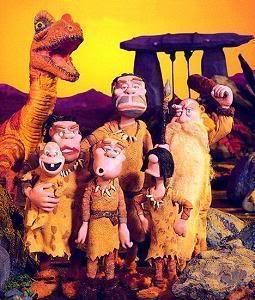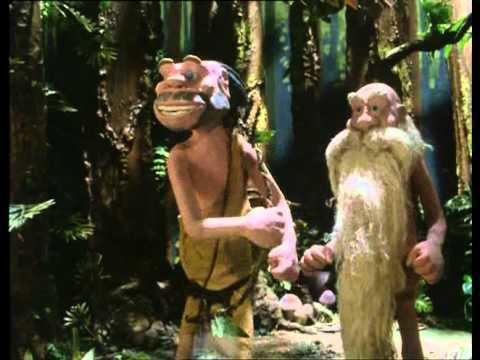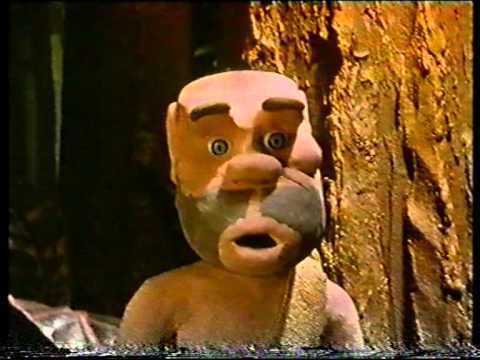7.7 /10 2 Votes
Country of origin Wales No. of episodes 13 (list of episodes) Final episode date 25 December 1998 | 8.4/10 IMDb No. of series 2 First episode date 7 December 1993 Language English | |||||||||||||||||||||||||||||||||
 | ||||||||||||||||||||||||||||||||||
Directed by Deiniol Morris, Michael Mort Producer(s) Helen NabarroMeirion DaviesColin Rose Running time 5 minutes30 minutes (movie) Genres Animation, Clay animation, Animated series, Animated cartoon, Children's television series, sitcom Similar The Trap Door, Crapston Villas, Plasmo, Bob and Margaret, Carland Cross | ||||||||||||||||||||||||||||||||||
Gogs the complete collection gogwana 1994 480p
Gogs!, or simply Gogs, is a claymation-style animated television series which takes the form of a sitcom, originally aired on Welsh television in 1993, and aired to the rest of the United Kingdom on the BBC in 1996. Gogs has since been aired internationally, and still enjoys re-runs on occasion.
Contents
- Gogs the complete collection gogwana 1994 480p
- Gogs episode 1
- Development
- Airings
- Later history and stalled film
- Plot
- Gogs
- Ray the T Rex
- Other animals seen
- Named episodes
- Critical
- Series
- Gogwana extended finale
- Releases and availability
- References

Gogs revolves around a family clan of dumb, primitive and socially inept cavemen in a fantasy prehistoric Stone Age setting, and contained much dark comedy, various toilet humour-based gags and gross out situations; for example the cavemen losing control of their bodily functions. It also featured their often comedic daily struggle for survival, and attempts to advance their technology and society, such as creating fire, and often failing miserably, comically and absurdly in the act.

In the Welsh language, the term 'Gogs' is slang for 'Gogledd' which translates as 'North' and 'gogs' as 'Northerners', the animation may have been a joke / play on the animators view of the North as being savage.

The show was more oriented towards an adult audience than other claymation television series such as The Trap Door or Wallace and Gromit, which were more child-friendly than Gogs. Although often called a children's television program, the "grungy" Gogs with its adult humor-based gags tended to be shown after the watershed, and so was often referred to as "claymation for the post-pub generation". Later VHS and DVD releases carried a parental guidance rating.

The original series contained only five episodes each of around five to six minutes long. After winning numerous awards a second series was commissioned with episodes running at a similar length, bringing the total number of episodes of the two series to thirteen in number. In 1998 the last installment of Gogs, a 30-minute-long special, Gogwana, was aired, which was also critically well received and won numerous awards.

Gogs episode 1
Development
Production of the show was a collaboration between numerous companies and individuals in 1993. Welsh animation studio Aaargh! Animation Ltd were among the most prominent of these, created specifically for the purpose of making Gogs. Later Aaargh Animation Ltd went on to produce the animated segments of the 1997 film A Life Less Ordinary, and numerous commercials including ones for Levi jeans. Gogs was initially the brainchild of Mike Mort and Deiniol Morris, who fronted Aaargh Animation, developed the pilot episode, and directed subsequent episodes, under executive producer Helen Nabarro. Welsh television station S4C provided some of the funding for Gogs (and originally aired the show on Welsh television), as did Harlech Television (HTV), and Bumper Films. Comedian/actress Josie Lawrence lent her voice to The Gogs, and it is also her shrieking tones heard on the end titles. Noted Welsh actress Gillian Elisa did most of the voices, however. Additional "voices" were provided by Marie Clifford, Dafydd Emyr, Rosie Lawrence, Rob Rackstraw, and Nick Upton.
Airings
The first series was brought initially to a minor Welsh audience by Meirion Davies of S4C in late 1993, complete with Welsh language titles, credits, subtitles and voice-overs, and thus incompatible with the wider English speaking world. Gogs sprung on to an international platform with the help of Colin Rose at the BBC, who had the show translated for an English-speaking audience and aired on BBC2 in the Christmas holidays of 1996. After this, a second series, Gogs II, was produced and aired in 1997, and in 1998 the Gogwana 30-minute special and finale.
Later history and stalled film
Both series of Gogs and the Gogwana special were critically well received and garnered numerous awards. However, Gogwana would prove to be the last ever episode of the show. The high costs of producing claymation compared to the emerging sophistication of computer-generated animation (even one episode of Gogs took a very long time to produce with the small team, little resources and funding they had), and the prime time slot allocated to Gogs which would be better filled with "more conventional" sitcoms, ensured that Gogs was not commissioned for a third series or another special by the BBC. Steven Spielberg and his newly founded DreamWorks had recently attempted to retain the services of Nick Park, head of British studio Aardman Animations and creator of Wallace and Gromit, to make an animated caveman film; however Aardman "resisted being bought by Hollywood lock stock and barrel." Soon after, Spielberg saw the first episode of Gogs, which revolves around the consequences of the Gogs discovering fire for the first time; Spielberg was being impressed by it he offered Gogs creators AAArgh! work in the United States instead of Aardman. Morris and Mort met with Spielberg at his ranch and admitted they would be tempted by an offer to produce a theatrical Gogs with DreamWorks, although no deal was made and there were no further developments to the plan. DreamWorks later resumed their contract with Park and Aardman, resulting in the films Chicken Run and Flushed Away. In 2005, Aardman announced they were working with DreamWorks on an animated caveman comedy without AAArgh!; it was to be called Crood Awakening in which a clan chief is threatened by the arrival of a prehistoric genius who comes up with revolutionary new inventions like fire. Co-written by John Cleese it eventually became the 2013 film The Croods.
Plot
The series depicts the Gogs comically as being mind-bogglingly stupid and struggling to navigate and avoid the perils of an exotic, prehistoric land inhabited by dinosaurs, prehistoric mammals, giant insects, man-eating plants, and other exotica. Even the primeval landscape is a danger, likely to erupt in a volcano or collapse in an earthquake, and the world is wracked by powerful lightning and thunder storms. One of the show's key comedic aspects are crudeness and toilet humour; the characters do not talk, instead communicating with grunts, roars, screams, burps and farts, and overly exaggerated facial expressions. The rest of the show had an emphasis on slapstick, cartoonish violence as the Gogs spend the rest of their time wrestling, urinating, vomiting, bashing each other on the head with clubs, and scoffing food. The show was criticized by some for being too over the top.
Gogs
Ray the T-Rex
A major supporting character and the primary antagonist of the show, Ray is a ravenous Tyrannosaurus rex who is frequently attempting to eat the Gog family clan, and is constantly stalking them wherever they go. In the first episode, when the characters are introduced in the opening credits, the T-Rex is said to be named Ray. Ray is used a designation for the T-Rex at other points in the show also. Ray's obsession with the Gogs may be as much down to revenge as hunger, as also in the first episode Ray is thwarted from eating the Gogs by having his private parts burnt by fire. In the second episode, Oglas and Ogo flee from the small dinosaur, only to discover a massive T.Rex which chases them off a cliff. Ray continues to appear in several episodes in the first series and in the half-hour special Gogwana.
Ray's depiction is inconsistent through the show and the T-Rex changes in size and appearance somewhat throughout the show; sometimes he is depicted as yellow, sometimes orange, sometimes red, and sometimes green. In the first episode Ray is smaller and faster (perhaps a juvenile T-Rex), and in later episodes he is depicted as slower but larger and generally more menacing. In the final half-hour special Gogwana, Ray, who is again stalking the Gogs, inadvertently saves them when he eats the new antagonist, the Cannibal King.
Other animals seen
Named episodes
Critical
Based on 241 user ratings, Gogs has a weighted average vote of 7.5 out of 10 on the Internet Movie Database. Of the IMDB users who rated the show, 43.2% rated it 10 out of 10.
Series
Gogs received international acclaim and won several awards, initially winning "Yr Animeiddio Gorau" (Welsh for Best Animation) for four years running in 1995, 1996, 1997, and 1998 at the Welsh BAFTA Cymru. Again, in 1995 the show won the international Children's BAFTA Award for Best Animation, and in the 1996 international BAFTAs, Gogs won the entry for Best Animation. In June 1996, Gogs won the award for best animation at the Banff television festival in Canada.
Gogwana extended finale
The thirty-minute-long special in 1998, Gogwana, which wrapped up the show, was also well received, winning several awards. These included the Banff Rockie award for Best Animation Program Award at the 1999 Banff Television Festival, and also winning the Audience Award for Best Film at the Rio de Janeiro Anima Mundi Animation Festival. It also won Best Children's Series at the 1998 British Animation Award. It was also nominated for Best Animated Short Film at the 1999 international BAFTAs.
Releases and availability
Both the first and second series of Gogs were released separately on VHS in 1997 by BBC Video with a parental guidance rating. With the airing of the thirty-minute long special Gogwana in 1998, Gogwana was also released separately on VHS.
Gogs was released as a Region 2 DVD on 9 April 2001 also by BBC Video. The DVD contains all thirteen episodes of both series, including the 30-minute special "Gogwana", all on a single disc, with a total run-time of 89 minutes. Special features include a rare photo gallery.
